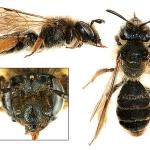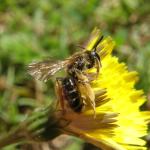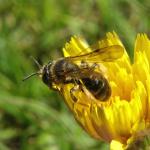The females of this medium-sized Andrena are quite distinctive, with the gaster having a terminal covering of bright golden-yellow hairs, a feature they share with only a few other British species. The males, on the other hand are, like most male Andrena, quite unremarkable, looking at first glance like those of
A. chrysosceles (Kirby), but readily told apart by the lack of yellow facial markings and the fact that they fly rather later in the year.
Found throughout southern and central England as well as in the south-eastern parts of Wales, although always local in occurrence. The species is not known in Scotland or Ireland, but does occur in the Channel Islands.
It is widespread in Europe, although much more frequent towards the south of the region.
This species is listed in Falk (1991) as Notable A (now known as Near Threatened).
Associated with open grasslands.
May to July.
Usually it nests singly, but has been reported in small aggregations.
All floral observations, for both males and females, have been on yellow-flowered Asteraceae.
No parasites have been recorded in Britain. Westrich (1989) refers to a report that Nomada integra Brullé is associated with this species but doesn’t list this Andrena as a host under the entry for the Nomada.
2012




